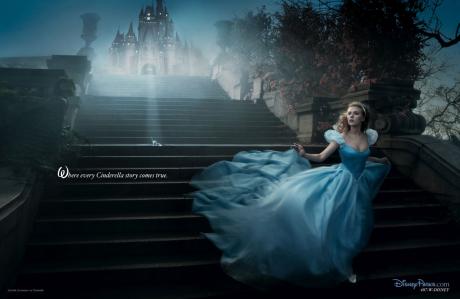A King and a Queen longed for children. A beggar woman told them they would have THREE daughters, but must not be out under the open air until they were all FIFTEEN years old. Prohibition=violation-they were let outside just before the youngest one's fifteenth birthday and were carried away by a snowdrift.
The King sets up a reward-half the kingdom and a princess of choice to anyone who could free the Princesses. Many tried and failed. Finally a Captain and a Lieutenant set on their way, followed by a Soldier who had dreamt the way to find the Princesses. His mother told him not to go yet-only if he dreamt the same dream THREE times would he know it was true. However, he did, and set off to find the Princesses.
He met up with the Captain and Lieutenant, making their company THREE. The Soldier had gotten meat from the King before his journey and used it THREE times-twice to distract hungry animals, and once to feed themselves.
While staying at a house, each hero was tricked by an old man who beat them with his crutches, except the Soldier, making it the THIRD time, who tricked the old man into telling him the rest of the way to the Blue Mountain. There were trials of fire and water-the Captain couldn't make it past the water, the Lieutenant couldn't make it past the fire, but the Soldier, the THIRD, made it past both and into pitch darkness-THREE trials. Once out of there, he found the first Princess, spinning copper yarn.
They concoct a plan to save her from the THREE headed monster. He takes a drink from a flask, weilds the Troll's sword, and cuts them off. On to the second Princess, spinning silver, and the same trick to cut off the SIX headed monster, but only after taking two sets of THREE draughts of drink. The THIRD Princess spins gold. THREE sets of THREE drinks enabled him to cut off the NINE headed monster, though each time it got more difficult.
Above illustrations by Kay Nielsen
The Soldier leads the Princesses back to the well he had come down, but the trecherous Captain and Lieutenant cut off the rope when they think they are hauling up the soldier. Left alone, the soldier searches and finds a whistle, which summons a flock of birds and a large eagle, who will transport him out once she has eaten TWELVE oxen.
Meanwhile the Princesses are dismayed at the thought of marrying the Captain and Lieutenant and say they will only marry when they can have a set of gold checkers just like the one in the mountains. The Soldier calls on the eagle to get it for him, and he and the Princesses reveal the truth. He marries the youngest-the THIRD-Princess.
So not only do these stories contain threes and multiples, but there's a sense of building up to the third as the climax. Many other well-known stories have this pattern too.


-Cinderella attends the ball THREE nights in a row (ignore the cheesy saying and just look at the pretty picture.)
-The two stepsisters plus Cinderella make THREE sisters
Illustration by Henry J. Ford, from Andrew Lang's Blue Fairy Book
-The maiden in Rumpelstiltskin has THREE nights on which she must spin gold.
-The Grimm's version even repeats that the bobbin goes "whirr, whirr, whirr! THREE times around"
-On the THIRD night, the baby is bargained-the climax
-The maiden has THREE nights to guess Rumpelstiltskin's true name
Illustration by Katherine Cameron
-There are TWELVE dancing Princesses, a multiple of three
-Each night they pass through THREE forests that get grander and grander-silver, gold, and diamonds
-They danced till THREE in the morning
-This happened THREE nights in a row-on the THIRD night the soldier takes a cup with him as well as the twigs
 Willy Planck
Willy PlanckThe Goose Girl
-The Princess' mother gives her a handkercheif with THREE drops of blood on it
-The Princess goes out to tend the geese THREE times before she is revealed
Long ago, people thought that as they had children, each time the children improved-like each was the "newest model," so to speak-and that helps to explain all the emphasis on the youngest siblings in fairy tales. The patterns of threes may have made them, easier to remember, although it makes reading them tiresome. Some versions spell out all the details three times and some just say "And the same thing happened again." It's very similar to the phrase we still use, "Third time's the charm." Yet in modern retellings of tales, we want a faster pace so we cut out the repetitions. Anyone reading the Grimm Snow White for the first time is schocked at her stupidity, accepting gifts from the Queen three times in a row, when they are obviously meant to be deadly. But this isn't a commentary on Snow White so much as following the traditional story-telling pattern.
From Surlalune's annotations to Goose Girl: "The reasons and theories behind three's popularity are numerous and diverse. The number has been considered powerful across history in different cultures and religions, but not all of them. Christians have the Trinity, the Chinese have the Great Triad (man, heaven, earth), and the Buddhists have the Triple Jewel (Buddha, Dharma, Sanga). The Greeks had the Three Fates. Pythagoras considered three to be the perfect number because it represented everything: the beginning, middle, and end. Some cultures have different powerful numbers, often favoring seven, four and twelve."
Also:"The number and/or pattern of three often appears in fairy tales to provide rhythm and suspense. The pattern adds drama and suspense while making the story easy to remember and follow. The third event often signals a change and/or ending for the listener/reader. A third time also disallows coincidence such as two repetitive events would suggest."





No comments:
Post a Comment